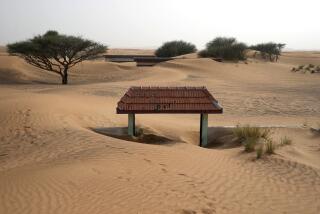Africa’s Ivory Coast Hopes Building Upon Its Colonial Past Will Enrich the Present
- Share via
GRAND LAHOU, Ivory Coast — Eighty years ago, vessels anchored off the European settlement of Grand Lahou, on the West African coast, to barter kitchenware, guns and spirits for palm oil, rubber and timber.
Today, this once-thriving trading post on the Bandama river estuary 90 miles west of Abidjan--Ivory Coast’s booming economic capital--is a ghost town inhabited by swarms of bats and a handful of Ghanaian fishermen.
But Ivory Coast, badly hit by slumping commodity prices, hopes to revive its colonial past as a tourist attraction.
“Our financial resources are very limited, but we are determined to save and revive our colonial heritage with the help of the international community,” a senior official at the Culture Ministry said.
Trash and debris from shipwrecks are piled against the remnants of Grand Lahou’s colonial architecture. Vines cling to the crumbling walls and carved balconies of dilapidated, roofless warehouses that were once packed with exotic goods.
French traders founded the settlement, built in 1890 on a narrow strip of inhospitable coast that was accessible only by dugout canoe or an occasional ferry.
In its heyday at the turn of the century, Grand Lahou boasted 6,000 inhabitants, had a wharf, a post office, a school, and for its 52 European residents, a tennis club.
Lack of drinking water and the construction in 1904 of a railway line linking Abidjan to the hinterland led to a steady decline.
Abidjan commissioned a deep-water port in 1954 to export the colony’s leading commodities--coffee, cocoa and timber--dealing a final blow to Grand Lahou’s economic hopes.
In 1975, the authorities ordered most of the residents to leave the town for better surroundings.
“In the long run, we want to turn Grand Lahou into a popular seaside resort within easy reach of Abidjan,” says Kindo Bouadi, in charge of the department of architectural preservation.
“As a first step, we are encouraging local people to restore the old houses by giving them away free. Unfortunately, the initial response has not been very encouraging and not much restoration has started but this is bound to take some time,” Bouadi said.
He said Ivory Coast pinned great hopes on financial help from UNESCO and industrialized nations.
The Paris-based United Nations Educational, Scientific and Cultural Organization has agreed in principle to list Grand Bassam, the country’s first colonial capital 25 miles west of Abidjan, as part of World’s Heritage.
The decision, to be officially announced later this year, means that UNESCO will support an international fund drive, scheduled for 1989, to restore Grand Bassam’s former splendor.
French traders and administrators deserted the bustling town in 1932 after the European population was decimated by yellow fever.
Today, Grand Bassam is a quiet town whose sandy beaches are invaded on weekends by Abidjan residents.
Grand Bassam’s landmark colonial building, the governor’s palace, has already been turned into a national costume museum while young ceramics craftsmen work rent-free in abandoned warehouses.
In last year’s austerity budget the government set aside $180,000--twice the 1980-85 appropriation--for building restoration.
To head off criticism that too much emphasis is put on colonial architecture, Bouadi said the ministry plans to renovate traditional buildings such as the local chieftain’s palace at Abengourou, in eastern Ivory Coast, which will become a regional museum.
More to Read
Sign up for Essential California
The most important California stories and recommendations in your inbox every morning.
You may occasionally receive promotional content from the Los Angeles Times.












